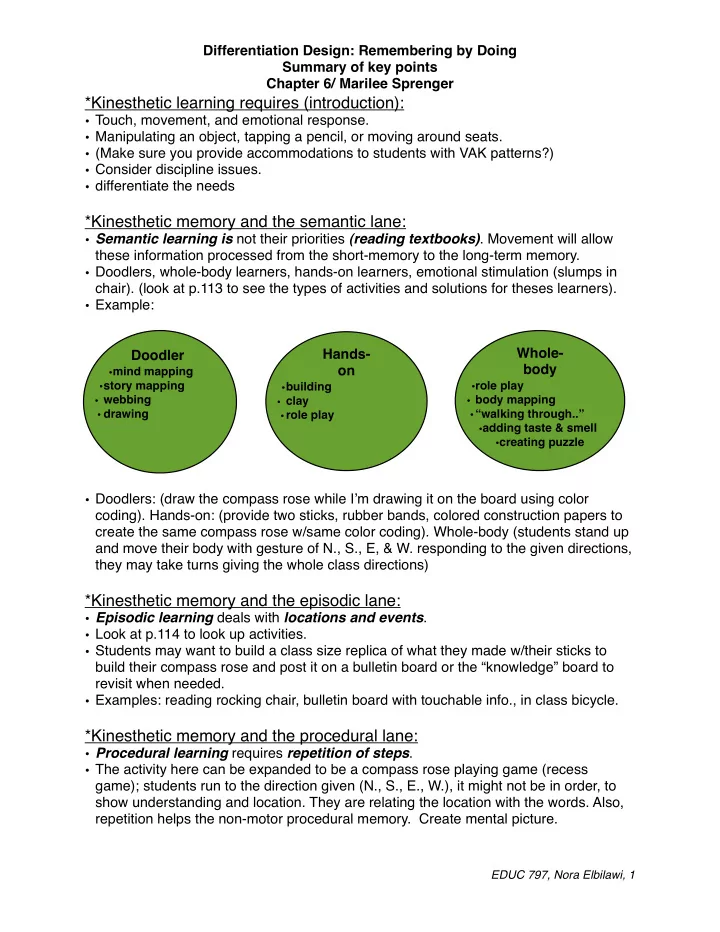

Differentiation Design: Remembering by Doing Summary of key points Chapter 6/ Marilee Sprenger *Kinesthetic learning requires (introduction): • Touch, movement, and emotional response. • Manipulating an object, tapping a pencil, or moving around seats. • (Make sure you provide accommodations to students with VAK patterns?) • Consider discipline issues. • differentiate the needs *Kinesthetic memory and the semantic lane: • Semantic learning is not their priorities (reading textbooks) . Movement will allow these information processed from the short-memory to the long-term memory. • Doodlers, whole-body learners, hands-on learners, emotional stimulation (slumps in chair). (look at p.113 to see the types of activities and solutions for theses learners). • Example: Whole- Hands- Doodler body on •mind mapping •story mapping •role play •building • webbing • body mapping • clay • drawing •“walking through..” •role play •adding taste & smell •creating puzzle • Doodlers: (draw the compass rose while I ʼ m drawing it on the board using color coding). Hands-on: (provide two sticks, rubber bands, colored construction papers to create the same compass rose w/same color coding). Whole-body (students stand up and move their body with gesture of N., S., E, & W. responding to the given directions, they may take turns giving the whole class directions) *Kinesthetic memory and the episodic lane: • Episodic learning deals with locations and events . • Look at p.114 to look up activities. • Students may want to build a class size replica of what they made w/their sticks to build their compass rose and post it on a bulletin board or the “knowledge” board to revisit when needed. • Examples: reading rocking chair, bulletin board with touchable info., in class bicycle. *Kinesthetic memory and the procedural lane: • Procedural learning requires repetition of steps . • The activity here can be expanded to be a compass rose playing game (recess game); students run to the direction given (N., S., E., W.), it might not be in order, to show understanding and location. They are relating the location with the words. Also, repetition helps the non-motor procedural memory. Create mental picture. EDUC 797, Nora Elbilawi, 1
Differentiation Design: Remembering by Doing Summary of key points Chapter 6/ Marilee Sprenger • Examples: procedural and step-by-step activity, index cards order, chronological time lines or pictures and graphs. *Kinesthetic memory and conditioned response: • In this lane, students are allowed and provided with the privilege of creation since they have “certain kinesthetic preference” like; auditorial, visual, etc. • Example: create songs or music, raps w/movement, computer drills, flash cards, and create cheers w/posters. *Kinesthetic memory and the emotional lane: • Emotional learning , usually students ʼ behaviors are guided through their feelings. They are capable of creating powerful emotional memory. Unfortunately, our educational system support the semantic pathways more than the emotional memory. • Examples: acting out stories, debate, dance, being part of a team, and modeling your enthusiasm. • This type of learning stores information in the long-term memory easily together with the emotions involved with it: curiosity, excitement, disappointment, etc. * Assessments for Kinesthetic learners: • They need specific types of assessment in order to evaluate their learning fairly (according to and in relation with their learning preferences). • Examples of assessments may include: drama, building a model, computer presentation, performing an experiment, gymnastics, etc. • Creating a rubric for such assessments may be tricky; however, laying down the expectations of the outcome products, for these students, is essential in order assure assessment validity. *Bloom ʼ s Taxonomy and the kinesthetic learner: • Levels of thinking: Comprehension Application Knowledge •Demonstrate •Build •Omit •Explain •Develop •Choose •Classify •Model •Relate Synthesis Analysis Evaluation •Combine •Categorize •Award •Estimate •Survey •Rate •Discuss •Discover •Perceive •Improve EDUC 797, Nora Elbilawi, 2
Differentiation Design: Remembering by Doing Summary of key points Chapter 6/ Marilee Sprenger • To promote these higher level thinking for kinesthetic learning you have to involve kinesthetic imagination, hands-on and movement strategies, and creation of higher level questioning & tasks. *The critter connection: • Providing stuffed animals into the classrooms to provide a feeling of security and belonging. (look at p.126-127) *Different Strokes:(p.127-129) All Rug rats learners need differentiation Learning Pushing is in the the right bag! buttons! Knowing Exercises their place! EDUC 797, Nora Elbilawi, 3
Differentiation Design: Remembering by Doing Summary of key points Chapter 6/ Marilee Sprenger Articles/ GMU library: Moving Poems: Kinesthetic Learning in the Literature Classroom. By: Zimmerman, Virginia. Pedagogy, Fall2002, Vol. 2 Issue 3, p409, 17p; Abstract Focuses on kinesthetic learning as a method to teach literature in the classroom. Role of kinesthetic learning on the understanding and appreciation of poetry; Examples of kinesthetic exercises during poetry classes; Views on active, experiential learning.; (AN 7446714) PDF Full Text (88KB) Add to folder Creative movement: A language for learning. By: Griss, Susan. Educational Leadership, Feb1994, Vol. 51 Issue 5, p78, 3p, 3 bw; Abstract Discusses the role of creative movement as a language for learning. Movement improvisation as an alternative avenue to understanding; Learning through a bodily-kinesthetic mode; Creative movement as language; Kinesthetic learning in the classroom; Advice for teachers with intentions of applying the method.; (AN 9406020902) PDF Full Text (736KB) Add to folder Google link: http://www.latitudes.org/articles/learn01.html Interesting articles: http://educationalissues.suite101.com/article.cfm/right_brain_characteristics http://educationalissues.suite101.com/article.cfm/left_brain_characteristics EDUC 797, Nora Elbilawi, 4
Recommend
More recommend